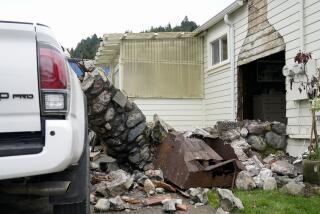Developments in Brief : Math Model Predicts Quakes
- Share via
UCLA geophysicists have developed a mathematical model to predict the probability of a moderate earthquake after a fore-shock is recorded, the first time a theoretical procedure has been directly linked with seismic data to forecast earthquakes.
Yan K. Kagan and Leon Knopoff said in the current issue of Science magazine that their method is unique in that it involves only three variables: the rate of occurrence of independent earthquakes and the time and distance separation of related earthquakes.
When they applied their method to a record of earthquakes along a 200-mile section of the San Andreas fault, from Parkfield north to San Francisco, for the years 1971 through 1977, their model was able to “predict” more than one-third of earthquakes with magnitudes greater than their fore-shocks.
Kagan said that not enough data are available to test their theory on more recent quakes in the region and that they cannot get seismic data from the U.S. Geological Survey fast enough to predict actual earthquakes.






